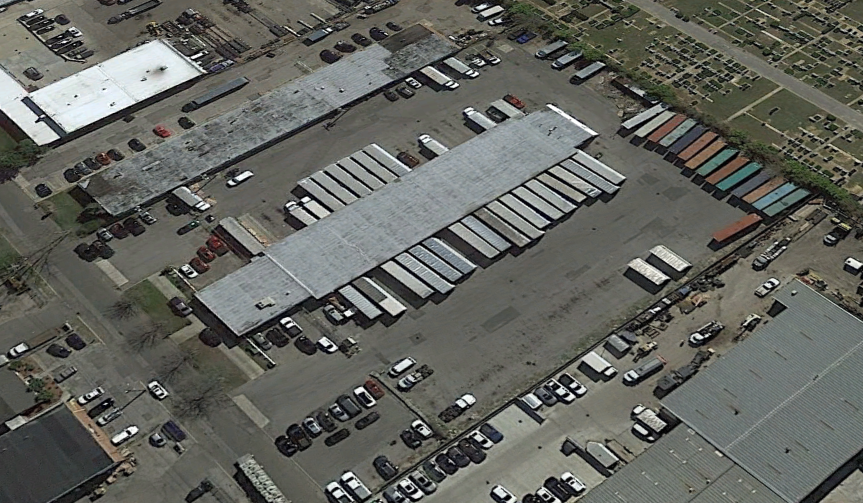The Case for Last-Mile Facilities

Anyone who’s had to dodge lumbering Amazon trucks on their neighborhood streets probably won’t be surprised to learn that the company plans to double its distribution center count for same-day delivery. Bringing this into the CRE realm: Should developers and investors pay more attention to last-mile distribution centers? According to CRE and logistics authorities well-versed in this specific issue, the answer is a qualified yes.
The last several years have seen corporations investing significantly in last-mile distribution facilities, said Ermengarde Jabir, senior economist at Moody’s. Leveraging the construction boom in all industrial property subtypes, these companies have added considerable square footage to the last-mile distribution supply.
Smaller facilities, such as this 16,000-square-foot building on Long Island, New York, owned by BEB Capital, are getting renewed attention as retailers race to deliver products faster. Image courtesy of BEB Capital
Even so, the medium to long term should still provide sizable opportunity in the niche, as a way of responding to the intensifying quest for ever-shorter delivery times. Demand should be particularly strong, Jabir said, for “medium-sized facilities that have sufficient storage capacities, while primarily serving as fulfillment centers for the goods in highest demand for a given geographic area.”
Businesses are repurposing urban spaces into micro-warehouses or distribution centers to enable quicker deliveries within the final mile, added Shivani Dogra, director with Acuity Knowledge Partners. She referenced a 2022 Wealth Management Real Estate survey, which revealed most investors showed a preference for last-mile distribution facilities as opposed to those in traditional locations. Among key findings was that in some instances, the price per square foot grew at a compound annual growth rate of 17.2 percent between 2017 and 2022, she noted.
READ ALSO: Top 5 Metros for Industrial Deliveries
Dogra also cited the 2022 comments of Joe Karmin, executive vice president of Transwestern, who observed that, based on location, last-mile distribution centers could generate rents 20 to 50 percent higher than regular facilities.
As for optimal size, end users typically prefer small buildings, in the sub-100,000-square-foot range, she added.
The notion of ideal size will typically differ from one company and location to another, but many operators, retailers and end users aim for properties from 15,000 to 50,000 square feet, while those ranging from 50,000 to 100,000 square feet might be optimal for larger players such as Amazon, she said.
Urban infill locations are increasingly valued because their settings close to population centers can slash delivery times and costs, said Robert Khachatryan, founder & CEO of Freight Right Global Logistics. Facilities extending from 50,000 to 200,000 square feet are optimal, he believes, due to being manageable within urban environments and able to handle large package volumes.
Target geographies
Geographic areas with the richest potential are those displaying comparatively stronger demand for e-commerce, as opposed to traditional brick-and-mortar retail, particularly in areas with younger-skewing demographics, Jabir reported.
“Additionally, metros that have grown quickly and continue to have strong population growth prospects over the near term as well as sustained expected growth over the next five to 10 years should be prioritized,” Jabir continued. “Being in close proximity to the trifecta of vital transportation infrastructure—seaports, airports and ground transportation arteries (such as) major interstates the likes of Interstate 95—is critical. Although there is also opportunity in being a first-mover in building in rapidly growing areas whose developed transportation infrastructure is still in the planning stages.”
READ ALSO: Retail Investors Are Adapting to Disruption. Here’s How.
For her part, Dogra noted the outskirts of U.S. metropolitan areas, traditionally the domain of manufacturers, are now preferred for last-mile distribution centers.
“As delivery cost per unit is very crucial for maintaining operator profitability, a location within 6 to 15 miles of high-density residential areas with comparatively (few) rentals will be the ideal space for these facilities,” she reasoned.
Khachatryan urged investors to focus on high-density metro areas such as New York City, Los Angeles and Chicago. “Secondary cities like Atlanta, Dallas and Miami also offer strategic advantages for regional distribution,” he added.
Buyer beware
Of course, there are risks, and Dogra pointed out some of them. First, added CapEx requirements such as construction and customization for specific products like large appliances may prove problematic.
Second, each additional warehouse in the supply chain hikes the cost of delivery per unit. Third, stiff competition in some locations might dampen returns. And fourth, operational hurdles such as traffic congestion and manpower availability might diminish the appeal.
Khachatryan added costs and competition as potential risks. In addition, he observed that zoning laws and the need for regulatory approvals can delay projects, particularly in the densely populated areas appealing to last-mile investors.
For Keyvan Ghaytanchi, CIO of BEB Capital, one primary danger stands out. “It is crucial to ensure that these facilities have alternative uses and (for investors) to hedge their strategies accordingly,” he said. “Market dynamics can shift, and having a diversified approach can mitigate risks associated with over-reliance on a single type of facility.”
Looking ahead is looking up
Moody’s estimates e-commerce retail sales as a percentage of total sales will grow to 20 percent by decade’s end. That translates to enormous upside opportunity for last-mile distribution and the industrial sector writ large, Jabir observed.
“Coupled with the ongoing push for the nearshoring and reshoring of manufacturing, the industrial sector is expected to continue to go from strength to strength, despite a temporary recalibration after a period of exponential growth,” she said.
Dogra is even more bullish on this industrial sector, reporting that a study conducted in 2022 by delivery management platform Bringg found 99 percent of retailers intend to provide same-day delivery by 2025. Multiple studies show the current figure at approximately 50 to 60 percent.
Dogra also quoted Aaron Jodka, director of research, U.S. capital markets at Colliers, as observing “demand for modern last-mile space is so strong that developers building facilities on speculation often have tenants already committed before they break ground.”
Finally, given last-mile logistics account for about 53 percent of overall shipping costs “investments in technology to improve and optimize logistics is imperative,” she said.
Khachatryan noted the last mile sector is anticipated to grow steadily in the years ahead, with that growth propelled by continuous e-commerce expansion. As reinforcement, he cited a 2020 report by the World Economic Forum, which predicted last-mile deliveries would surge 78 percent by the year 2030.
“Continued adoption of AI and IoT technologies will optimize route planning and inventory management, improving efficiency,” he predicted. “Investors will need to consider green building practices and electric delivery vehicles as sustainability becomes a critical factor in urban logistics. These factors indicate a robust growth trajectory for last-mile distribution facilities, presenting significant opportunities for investors who strategically navigate the associated challenges.”
The post The Case for Last-Mile Facilities appeared first on Commercial Property Executive.



